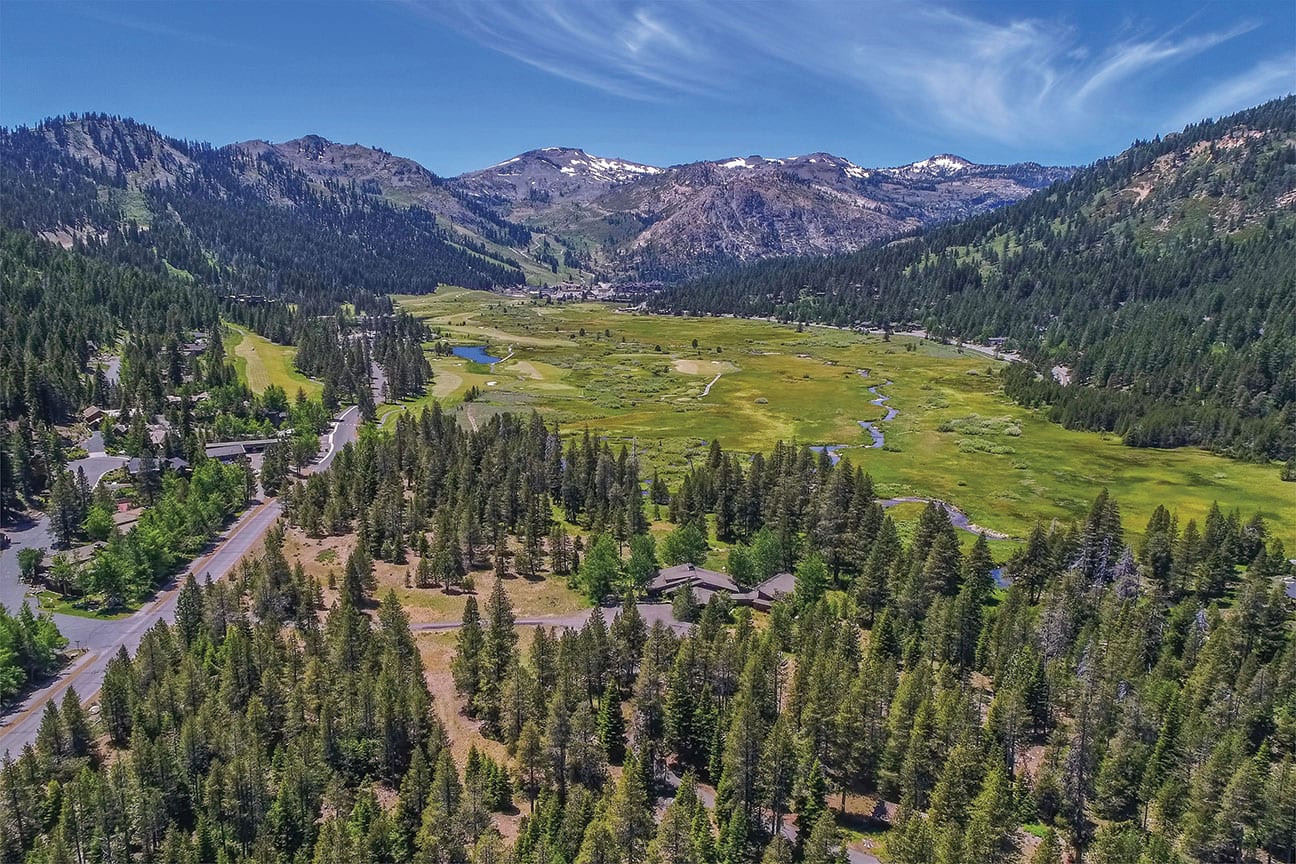
01 May Preserving the Poulsen Legacy
Local groups join forces in an effort to purchase the scenic property and home of Squaw Valley’s founding family
Situated on the threshold where forest meets meadow in Olympic Valley, a 5,435-square-foot home faces west on 30 acres of land. Squaw Creek meanders through the property, bubbling with snowmelt in the springtime. Tall pines sway overhead, and just out the backdoor, the meadow offers an unimpeded view of the Sierra Crest. It is a place that invites a moment of reflection.

The home was designed by Wayne Poulsen Jr., photo by Peter Tye
The Washoe Tribe once summered here, fishing trout out of the river and weaving baskets from willow branches. Between 1942 and 1946, Wayne and Sandy Poulsen—who pioneered skiing at Squaw Valley—acquired the property and every year thereafter hosted a large barbecue on the banks of the creek with their family and friends. In the mid-1970s, Sandy and Wayne chose this idyllic spot to build their dream home, where they would live out the rest of their years.
Now, the land, which is listed for $15 million, has an opportunity to become a launch pad for public access to the outdoors, a gathering place for the community, a piece of environmental conservation and a point of reference in Squaw Valley’s decades-old political divisions—so long as a grassroots effort involving the Squaw Valley Public Service District, the Truckee Donner Land Trust, donors and local residents can pull together enough money to close escrow.
It could also become the next development proposed in Squaw Valley, with zoning to build just under 300 bedrooms. But with the bitter taste left from a recent feud over a proposed development in the parking lot at Squaw Valley, and the tide of grassroots opposition that followed, more development is precisely what residents and community members say they want to avoid.
“We have an opportunity not just to acquire a beautiful piece of land, but also to change our contentious culture,” Fred Ilfeld, board director of the Squaw Valley Public Service District, said at a community meeting in March.
An Unparalleled Opportunity
After a long streak of winter storms, the property was buried beneath a deep snowpack and was invisible to the thousands of skiers driving to the resort every day, save for a narrow gap in the 10-foot snow berms along the road. Wayne and Sandy died in 1995 and 2007, respectively, and the property is now part of Sandy’s estate. But Sandy—who was a matriarch in their family and also for the greater Squaw Valley community—was clear in her wishes for her home and this piece of land. It must sell.

The Poulsen home in a March snowstorm, photo by Ryan Salm
Whether it was the threat of another development project in Squaw Valley, or the sheer uniqueness of an opportunity to shepherd a large parcel on Squaw Valley’s meadow toward public access, the motivators were strong enough to inspire two local groups to collaborate and enter an agreement to buy the property.
If all goes according to plan, the Truckee Donner Land Trust would steward half of the property as a conservation easement, and guide the restoration of the creek and the meadow. The other half of the property would be managed by the Squaw Valley Public Service District for recreation, though what that could be is largely a blank slate open for dreaming. The collaboration has not been finalized, but Mike Geary, general manager for the Squaw Valley Public Service District, said it would leverage each agency’s strength.
In December 2018, the Truckee Donner Land Trust board voted unanimously to put down a deposit and trigger the next steps in the real estate transaction, including an appraisal. The Land Trust has also engaged its fundraising muscle, seeking private donations and going after public funds like Proposition 68, a $4.1 billion bond that California voters approved in November 2018 for parks protection and outdoor access.
The Land Trust has been the driver behind some of the most important land acquisitions for conservation in the Truckee region since 1990 and has protected more than 36,000 acres. This property, which the group is calling “Olympic Meadow,” is its first campaign in Squaw Valley.
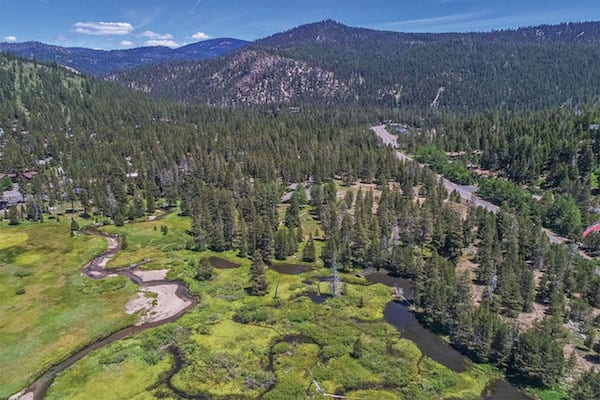
A bird’s-eye view of the property, photo by Peter Tye
“We are excited and humbled, actually, that this is our first project in Squaw,” said Perry Norris, Land Trust executive director.
Meanwhile, the Squaw Valley Public Service District is looking to spread the word to the residents and community.
Geographically and politically, Squaw Valley is a pocket community that is unincorporated, meaning there is no town council and decisions are made by Placer County on the other side of the mountains in Auburn. The service district is the closest thing to a local jurisdiction, though the scope of its work is clear: provide water, sewer and garbage services, and run the fire department. For years, the community has come to the service district to provide more recreation—like the Tahoe City Public Utility District does just down the street.
But so far, the extent of recreation the service district provides is plowing the bike paths in the winter, which the county contracts it to do. Managing the Poulsen property, and turning it into a public park, would be an opportunity for the service district to answer residents’ call.
The March meeting was the second open house the service district hosted, giving the public an opportunity to take in some of the Poulsen family history and legacy left in Squaw Valley.
“We are committed to a transparent, robust conversation with the community on how to move forward with this,” Geary said.
But the deal is still a long way from done.
“It has as much a chance to fail as it does to succeed at this point in time, and we’re trying to improve those odds toward success,” said Geary.
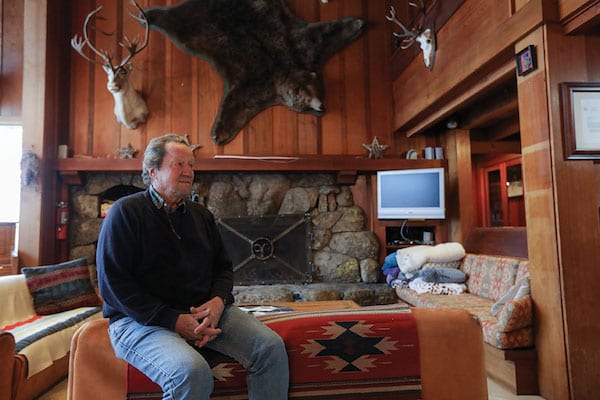
Wayne Poulsen Jr. sits in the living room of the Squaw Valley home that he designed for his parents, photo by Ryan Salm
Poulsen Memories
History is written on the walls of the Poulsen house. Family pictures show a time when buttercups carpeted the meadow—a bloom that never came back after cars parked on the meadow for the 1960 Olympics. On a Thursday afternoon in March, Wayne Jr. looked at the pictures and noted that all that family history was created by his parents’ adventurous and ambitious spirit.
“Never think that you can’t make a difference, or make a change, or make things better, because you can,” said Wayne Jr., who designed the home for his parents. “All of this was done in one lifetime.”
Next to the front door, a plaque reads “Casa de la familia Poulsen.” When designing the home, Wayne Jr. took inspiration from the “mountain houses” common in Norway, Austria and Switzerland, where Wayne Sr. traveled as a pilot for Pan American Airways. It has four bedrooms, with a two-car garage, a caretaker’s unit and an indoor pool. The fireplace is built of stone, and huge wooden beams hold up the vaulted ceiling. Wood paneling makes the place feel warm, even though no one has lived there in years.
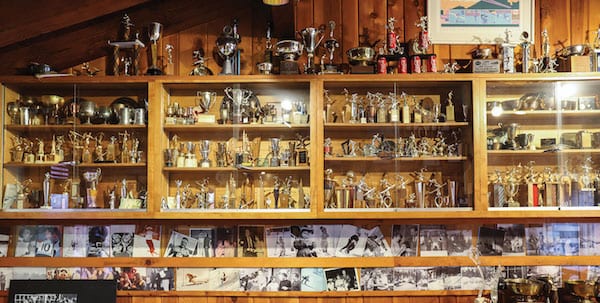
The Poulsens’ trophy room, photo by Ryan Salm
“The kitchen, for sure, is Sandy,” said Barbara Ilfeld, wife of Fred and a friend of Sandy. “I can just see her moving around in here, in this space, the tile, the wood, the warmth, and the arches. Sandy sculpted life. She sculpted a life for her family here in the most beautiful way.”
The house was intentionally built low to the ground so when Sandy stepped out the sliding glass door to her backyard, she immediately set foot on the meadow. Sunlight streams in through floor-to-ceiling windows oriented toward the view. A piano sits next to the glass, so someone could play music while looking at the mountains.
Evidence of Wayne Sr.’s passion as a sportsman hangs from the walls: a bear skin, elk heads and antlers. They are a contrast to the gold statues displayed in the “trophy room,” mementos of the Poulsen family’s many ski racing accomplishments.
Custodians of the Valley
At the March meeting, Barbara read a letter written by Sandy about her family’s time in Squaw Valley in the 1940s. The letter fondly recalls camping on the banks of Squaw Creek and the “chameleon like beauty” of the valley. Sandy and her children would float down the creek in the spring as snow melted from the mountains. The sound of cowbells ushered in summer, when cattle would graze.
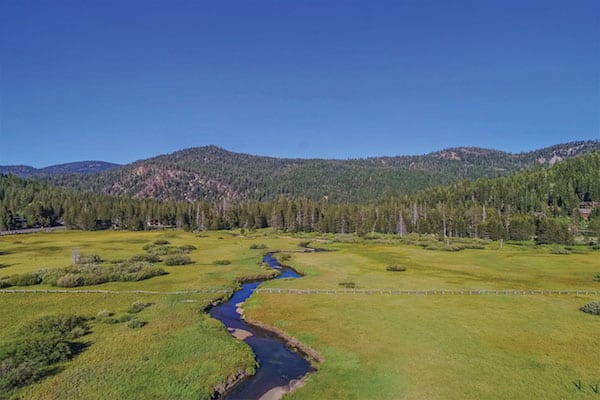
Squaw Creek meanders through the property on its way to the Truckee River, photo by Peter Tye
“This is the story of a happy life, one family’s answer to the perpetual pursuit of happiness,” Sandy wrote in the letter. “The full credit for our life here goes to my husband, a man with the dream who had the courage and the initiative to make his dream come true in spite of seemingly insurmountable obstacles. Not some sweet day, but now.”
The Poulsens were stewards of family, but also community. Their legacy is manifested in the view that stuns skiers every day, when they drive around the corner on the way to the lifts and see the meadow open up before the road. As the major landowners in the valley, the Poulsens guided development in the forested hills along the perimeter of the valley, and passionately worked to preserve the openness of the meadow. That work took a nosedive toward controversy when the Olympics arrived and Squaw Valley owner Alex Cushing threatened to pave the entire meadow for parking. Instead, Cushing compromised and laid down sawdust. Still, the buttercups never came back.
“We have that kind of history,” said Ilfeld, standing in front of the board room at the Squaw Valley Public Service District during the community meeting. An older man wearing spectacles and a thick sweater, Ilfeld laid out the stakes plainly, highlighting three factors that have recently changed or evolved the political and social landscape of the community in Olympic Valley. He said he hopes to see things “move from a tradition of divisiveness toward a culture of collaboration in the valley, along with the emotional healing that we all want and need.”
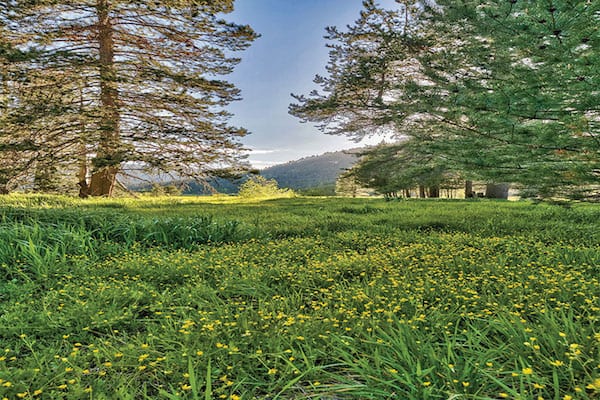
Flowers dot a lush landscape where forest meets meadow, photo by Peter Tye
His audience didn’t need an explanation of context. As residents of Squaw Valley, they had all witnessed and experienced the sharp division that unfolded recently when the ski resort proposed a large development project in the parking lot at the west end of the meadow. Like the earlier battles between the Poulsens and Cushings, the modern dramas have drawn lines in the sand between the people who have a business interest here and the people who live here.
First, Ilfeld continued, the contentious Village at Squaw Valley Redevelopment is no longer being fought in the public arena. Rather, it is confined to the courts. “This means that any disagreements about the scope of the village development needn’t keep us from working together on jointly desired projects,” said Ilfeld.
Second, Squaw Valley Alpine Meadows has new ownership and administration. “Alterra’s professed goal is to develop their different ski areas by resonating with and enhancing the unique strengths of the local culture and the ski experience,” said Ilfeld. Notably, however, Alterra Mountain Company, which owns Squaw Alpine, was a voice that was absent in the March meeting, as was the Resort at Squaw Creek. Ilfeld said both are aware of this effort and they will be brought into the conversation soon.
The third change, said Ilfeld, is the “unparalleled opportunity” to acquire an Olympic Meadow property. “It will require all of us—all stakeholders in Squaw Valley—pushing together, shoulder to shoulder, in the same direction for this to happen.”
A Natural Addition
Even though Sandy and Wayne had a big family, they built this house for the two of them. (Their previous residence closer to the ski slopes is now Graham’s restaurant.) “As Wayne would say, the bedrooms upstairs are small. They’re not meant for people to stay a long time,” said Valerie Forte, who is the listing agent with Engel and VÖlkers on the property.
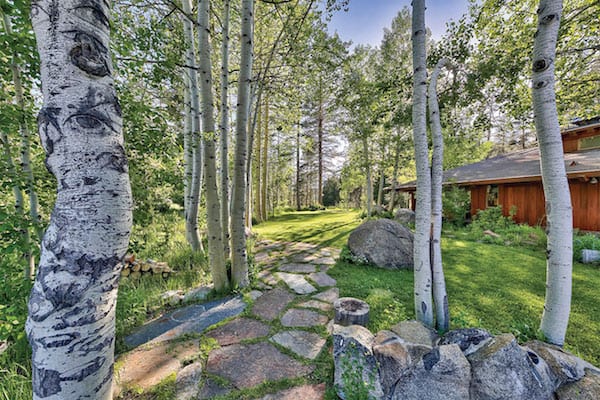
A stone paver path winds through an aspen grove just outside the house, photo by Peter Tye
Talking to a small group of people in front of the fireplace that day in March, Wayne Jr. was blunt about the future of the house—it is “de minimis.” The land, though, is “remarkable.” Just outside the house, Wayne Jr. built a memorial to his father, a meditation garden with eight stones, one for each child to sit on, so they could form a circle to listen to whomever had the talking stick and stood in the center.
A feasibility study is underway to determine whether or not the residence could be kept, which could depend on the updates the structure would need if it were rezoned from a single-family home to a public gathering place. At the same time, Geary and the Squaw Valley Public Service District are working to do a survey of the almost 600 registered voters in the valley. A revenue measure will be on November’s ballot for voters to approve a parcel tax to fund the acquisition and the continued maintenance of the property. How much the valley’s residents and businesses will be taxed depends on the success of the Truckee Donner Land Trust’s fundraising efforts, and the costs and budget to maintain the property, which are still being determined. If all goes well, and the two agencies are able to close escrow, the district will work on passive recreation on the property—building things like trails, park benches, picnic tables and parking—while also kick-starting a long-term vision and plan for what this place could become.
“This is a yin and yang to the mountain. The mountain is adrenaline, excitement, high effort. But this place is more meditative, peaceful, reflective,” Ilfeld said. “They each have their own beauty. They’re very different. To me, it’s a natural addition.”
Julie Brown is a freelance journalist based in Reno. She learned to ski at Squaw Valley.




No Comments